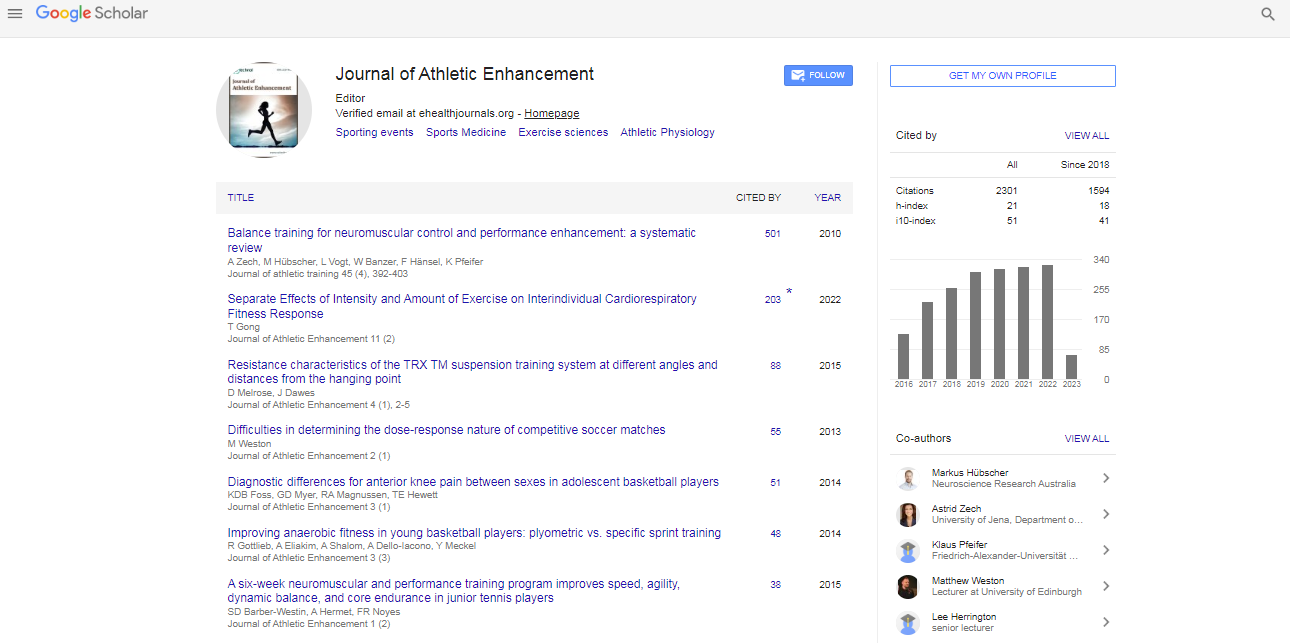Short Communication, J Athl Enhanc Vol: 12 Issue: 4
An Overview on Baseball Swing: Its Importance of Coaching and Practice
Aditya Kumar*
1Department of Orthopaedics, All India Institute of Medical Sciences, Rishikesh, India
*Corresponding Author: Aditya Kumar,
Department of Orthopaedics, All India
Institute of Medical Sciences, Rishikesh, India
E-mail: kuma@aditya.edu.in
Received date: 09 June, 2023, Manuscript No. JAE-23-112384;
Editor assigned date: 12 June, 2023, PreQC No. JAE-23-112384 (PQ);
Reviewed date: 26 June, 2023, QC No. JAE-23-112384;
Revised date: 03 July, 2023, Manuscript No. JAE-23-112384 (R);
Published date: 10 July, 2023 DOI: 10.4172/2324-9080.1000094
Citation: Kumar A (2023) An Overview on Baseball Swing: Its Importance of Coaching and Practice. J Athl Enhanc 12:4.
Description
The baseball swing is a captivating blend of power, precision, and timing that defines the essence of America's pastime. Whether you're a fan, player, or simply someone who appreciates the beauty of sports, the sight of a perfectly executed baseball swing can be mesmerizing. In this essay, we will explore the intricacies of the baseball swing, delving into its mechanics, the mental aspect, and the history that has shaped it into an art form [1].
Concentration hitting a baseball is often considered one of the most challenging tasks in sports. It requires intense concentration and focus. The batter must pick up the spin, speed, and location of the pitch within milliseconds and make split-second decisions [2,3].
Plate discipline a crucial mental aspect of the baseball swing is plate discipline. This means the batter's ability to discern between strikes and balls, resisting the temptation to swing at pitches outside the strike zone. A disciplined batter increases their chances of getting a pitch they can drive.
Visualizing success many successful batters visualize their success before stepping into the batter's box. They mentally rehearse their swing, imagining the ball connecting with the bat and sailing into the outfield. Visualization helps build confidence and can positively influence performance [4-6].
Handling pressure baseball is a game of pressure situations, from the bottom of the ninth inning with the bases loaded to the pitcherbatter duel in a tie game. Mental toughness is a key in these situations, as maintaining composure and confidence can make all the difference in executing a perfect swing.
The evolution of the baseball swing
The dead ball Era In the early days of baseball, the emphasis was on contact hitting and placing the ball in play. The dead ball era, characterized by low-scoring games and a lack of home runs, saw batters using a compact, controlled swing to make contact and move runners [7].
The Power Revolution Baseball underwent a significant transformation with the advent of the live ball era in the 1920s. The baseball swing evolved to incorporate more power and explosiveness, thanks to legends like Babe Ruth, who showcased the potential of hitting home runs [8].
The importance of coaching and practice
The role of coaches play a pivotal role in helping batters refines their swings. They provide guidance on mechanics, offer feedback, and help batters develop a consistent approach at the plate. Professional players often credit their coaches for their success.
Practice Makes Perfect The adage "practice makes perfect" holds true in baseball. Hours of batting practice, tee work, and live pitching are essential for developing muscle memory and honing the skills necessary for a successful swing [9].
Video Analysis Advancements in technology have allowed players and coaches to use video analysis to dissect swings frame by frame. This tool provides invaluable insights into areas for improvement, helping batters make adjustments to their mechanics [10].
The baseball swing is a beautiful amalgamation of physical skill, mental fortitude, and historical significance. From its humble beginnings in the dead ball era to the modern power-hitting era, the swing has evolved into a mesmerizing art form that captivates fans around the world. Through the fundamentals, mental aspects, and the history of its evolution, we gain a deeper appreciation for the skill and dedication required to master the baseball swing. Whether you're watching a professional player launch a majestic home run or a little league batter take their first swing, the baseball swing remains one of the most iconic and enchanting sights in sports.
References
- Meadows J, Kraut M, Guarnieri M, Haroun RI, Carson BS (2000) Asymptomatic chiari type I malformations identified on magnetic resonance imaging. J Neurosurg 92(6):920-926.
- Strahle J, Muraszko KM, Kapurch J, Bapuraj JR, Garton HJL, et al. (2011) Chiari malformation type I and syrinx in children undergoing magnetic resonance imaging. J Neurosurg Pediatr 8(2):205-213.
- Smith BW, Strahle J, Bapuraj JR, Muraszko KM, Garton HJL, et al. (2013) Distribution of cerebellar tonsil position: Implications for understanding Chiari malformation. J Neurosurg 119(3):812-819.
- Kahn EN, Muraszko KM, Maher CO (2015) Prevalence of Chiari I malformation and syringomyelia. Neurosurg Clin North Am 26(4):501-507.
- Carey M, Fuell W, Harkey T, Albert GW (2021) Natural history of Chiari I malformation in children: A retrospective analysis. Childs Nerv Syst 37(4):1185-1190.
- Aboulezz AO, Sartor K, Geyer CA, Gado MH (1985) Position of cerebellar tonsils in the normal population and in patients with Chiari malformation: A quantitative approach with MR imaging. J Comput Assist Tomogr 9(6):1033-1036.
- Barkovich AJ, Wippold FJ, Sherman JL, Citrin CM (1986) Significance of cerebellar tonsillar position on MR. AJNR Am J Neuroradiol 7(5):795-799.
- George TM, Higginbotham NH (2011) Defining the signs and symptoms of Chiari malformation type I with and without syringomyelia. Neurol Res 33(3):240-246.
- Langridge B, Phillips E, Choi D (2017) Chiari malformation type 1: A systematic review of natural history and conservative management. World Neurosurg 104:213-219.
- Chatrath A, Marino A, Taylor D, Elsarrag M, Soldozy S, et al. (2019) Chiari I malformation in children-the natural history. Childs Nerv Syst 35(10):1793-1799.

